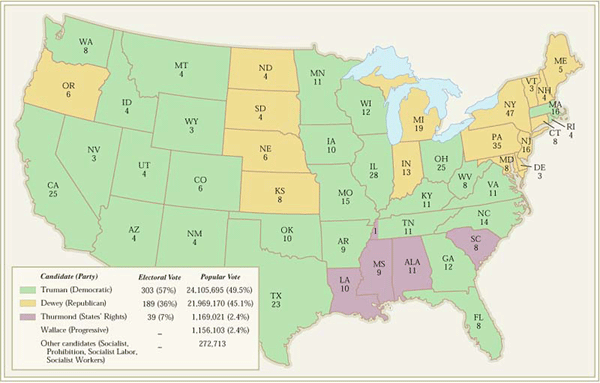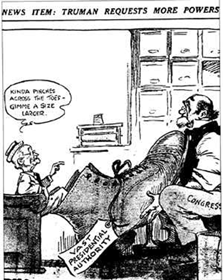Stanley K. Schultz
Professor Emeritus of History
University of Wisconsin-Madison
 |
||||||
|
|
|
||||
[voice of Thomas E. Dewey] "We now know that government Dewey will carry New York state by at least 50,000 votes and that he will be the next president of the United States." Dewey had not won; Harry Truman had pulled off one of the greatest upsets in American political history. In fact, he had won rather handily. In the Electoral College, Harry Truman had ended up with 303 votes to Dewey's 189 to Strom Thurmond's 39. Liberalism was not quite dead yet in America in 1948. Why did Harry Truman win? Well, he won for essentially three reasons. Number one, he won because of Republican overconfidence. Number two, he won because of his courageous stance in the face of such overwhelming odds.
Voters who had been undecided finally ignored all the national polls and decided that a man who was so gutsy, a man who was willing to labor so hard for the job, a man who was willing to stand up for what he believed was right, deserved their vote. But third, and most importantly, Harry Truman won primarily because he was able to bring back together some of the major elements in that New Deal coalition that Roosevelt had put together a decade earlier. After the rocky days of 1946, Truman brought back into the fold the labor vote; he won in the farm belt where he seemed to have a far better grasp of farmers' needs than did Dewey; he drew the vote of black Americans who viewed his civil rights stance preferable to that of any of the alternatives. The fragmentation of the Democratic Party, which pollsters had said would deep-six Harry Truman, turned out to be to his advantage, because it allowed him to ignore the ultra-left wing and ultra-right wing of the Democratic Party, and instead go for the votes of the moderates in the middle. Truman Calls
for a "Fair Deal" Truman faced an ever stronger conservative coalition. He tried to send and push through this conservative coalition in Congress major social legislation—social legislation which consisted of some programs that the earlier Congress had struck down as well as new ventures. What were the major Fair Deal proposals that Truman sent? Well, there were many but I think that six will be enough for us to get a sense of what the Fair Deal was all about. Let me just list these six for you briefly without going into great detail and without putting them in any ranked order or priority. Number one, civil rights measures. Number two, federal housing programs. There had been federal attempts to deal with housing in the 1930s. Truman went well beyond those and proposed a national housing program that would guarantee good quality housing for every family in America. Number three, a massive expansion and extension of the unemployment benefits that had first been put in place during the New Deal years. Number four, major new tax cuts for the poor and for low-income Americans. Number five, massive new attempts to gain federal funding for education throughout the country. Number six, as a major Fair Deal proposal, a comprehensive federal health-care program, and federal national health insurance
Well, these were Truman's Fair Deal proposals. Did they work? No. At best, the Fair Deal was a mixed bag of failures and successes. Truman ran into heavy congressional opposition. He did get through Congress a kind of omnibus housing act in 1949, that committed the federal government in part to furthering its housing programs. Truman got essentially nowhere in his civil rights proposals. He did get a slight rise in minimum wage. He didn't get very far in the unemployment benefits. He got nowhere with the tax cuts for the low-income and the poor. He got nowhere with his federal education programs. And he got absolutely nowhere with his national health insurance and federal health care proposals. It's important to remember that Truman himself was not so much at fault. As the conservative coalition had come to dominate Congress, that coalition was not about to support either an extension of the New Deal, or a massive expansion of social welfare programs on the home front in America. And so, certainly we can see that there was a shift to the political right during the late 1940s and into the early 1950s. Those Fair Deal proposals would have to wait for a far more liberal set of administrations and a far more liberal Congress under John F. Kennedy and under Lyndon Baines Johnson in the 1960s. But, you'll remember I also mentioned there was a turn to the economic right during the late 40s and the early 1950s. And let's for a few minutes turn our attention to what was going on in the economy under Harry Truman, and get a sense of this turn to the right. |
||||||

